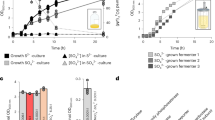Abstract
In the aerobic methanotrophic bacteria Methylomicrobium alcaliphilum 20Z, Methylococcus capsulatus Bath, and Methylosinus trichosporium OB3b, the biochemical properties of hydroxypyruvate reductase (Hpr), an indicator enzyme of the serine pathway for assimilation of reduced C1-compounds, were comparatively analyzed. The recombinant Hpr obtained by cloning and heterologous expression of the hpr gene in Escherichia coli catalyzed NAD(P)H-dependent reduction of hydroxypyruvate or glyoxylate, but did not catalyze the reverse reactions of D-glycerate or glycolate oxidation. The absence of the glycerate dehydrogenase activity in the methanotrophic Hpr confirmed a key role of the enzyme in utilization of C1-compounds via the serine cycle. The enzyme from Ms. trichosporium OB3b realizing the serine cycle as a sole assimilation pathway had much higher special activity and affinity in comparison to Hpr from Mm. alcaliphilum 20Z and Mc. capsulatus Bath assimilating carbon predominantly via the ribulose monophosphate (RuMP) cycle. The hpr gene was found as part of gene clusters coding the serine cycle enzymes in all sequenced methanotrophic genomes except the representatives of the Verrucomicrobia phylum. Phylogenetic analyses revealed two types of Hpr: (i) Hpr of methanotrophs belonging to the Gammaproteobacteria class, which use the serine cycle along with the RuMP cycle, as well as of non-methylotrophic bacteria belonging to the Alphaproteobacteria class; (ii) Hpr of methylotrophs from Alpha- and Betaproteobacteria classes that use only the serine cycle and of non-methylotrophic representatives of Betaproteobacteria. The putative role and origin of hydroxypyruvate reductase in methanotrophs are discussed.
Similar content being viewed by others
Abbreviations
- Hpr:
-
hydroxypyruvate reductase
- RuBP:
-
ribulose bisphosphate
- RuMP:
-
ribulose monophosphate
References
Trotsenko, Y. A., and Murrell, J. C. (2008) Metabolic aspects of obligate aerobic methanotrophy, Adv. App. Microbiol., 63, 183–229.
Whittenbury, R. (1980) The interrelationship of autotrophy and methylotrophy as seen in Methylococcus capsulatus (Bath), Proc. Int. Symp. “Microbial Growth on C1 com-pounds”, Heyden, London, pp. 181–190.
Baxter, N. J., Hirt, R. P., Bodrossy, L., Kovaks, K. L., Embley, T. M., Prosser, J. I., and Murrell, J. C. (2002) The ribulose-1,5-bisphosphate carboxylase/oxygenase gene cluster of Methylococcus capsulatus (Bath), Arch. Microbiol., 177, 279–289.
Ward, N., Larsen, Q., Sakwa, J., Bruseth, L., Khouri, H., Durkin, A. S., Dimitrov, G., Jiang, L., Scanlan, D., Kang, K. H., Lewis, M., Nelson, K. E., Methe, B., Wu, M., Heidelberg, J. F., Paulsen, I. T., Fouts, D., Ravel, J., Tettelin, H., Ren, Q., Read, T., DeBoy, R. T., Seshadri, R., Salzberg, S. L., Jensen, H. B., Birkeland, N. K., Nelson, W. C., Dodson, R. J., Grindhaug, S. H., Holt, I., Eidhammer, I., Jonasen, I., Vanaken, S., Utterback, T., Feldblyum, T. V., Fraser, C. M., Lillehaug, J. R., and Eisen, J. A. (2004) Genomic insights into methanotrophy: the complete genome sequence of Methylococcus capsulatus (Bath), PLoS Biol., 2, 1616–1628.
Shishkina, V. N., Yurchenko, Y. Y., Romanovskaya, V. A., Malashenko, Y. R., and Trotsenko, Y. A. (1976) About alternative of methane assimilation pathways in obligate methylotrophs, Mikrobiologiya, 45, 417–419.
Khmelenina, V. N., Kalyuzhnaya, M. G., Sakharovsky, V. G., Suzina, N. E., Trotsenko, Y. A., and Gottschalk, G. (1999) Osmoadaptation in halophilic and alkaliphilic methanotrophs, Arch. Microbiol., 172, 321–329.
Sambrook, J., and Russell, D. W. (2001) Molecular Cloning: A Laboratory Manual, 3rd Edn., Cold Spring Harbor Laboratory, N.-Y.
Reshetnikov, A. S., Mustakhimov, I. I., Rozova, O. N., Beschastny, A. P., Khmelenina, V. N., Murrell, J. C., and Trotsenko, Y. A. (2008) Characterization of the pyrophos-phate-dependent 6-phosphofructokinase from Methylo-coccus capsulatus Bath, FEMS Microbiol. Lett., 288, 202–210.
Slater, G. G. (1969) Stable pattern formation and determi-nation of molecular size by pore-limit electrophoresis, Anal. Chem., 41, 1039–1041.
Izumi, Y., Yoshida, T., Kanzaki, H., Toki, S., Miyazaki, S. S., and Yamada, H. (1990) Purification and characteriza-tion of hydroxypyruvate reductase from a serine-producing methylotroph Hyphomicrobium methylovorum GM2, Eur. J. Biochem., 190, 279–284.
Chistoserdova, L., and Lidstrom, M. (1991) Purification and characterization of hydroxypyruvate reductase from the facultative methylotroph Methylobacterium extorquens AM1, J. Bacteriol., 173, 7228–7232.
Rozova, O. N., Khmelenina, V. N., Bocharova, K. A., Mustakhimov, I. I., and Trotsenko, Y. A. (2015) Role of NAD+-dependent malate dehydrogenase in the metabo-lism of Methylomicrobium alcaliphilum 20Z and Methylosinus trichosporium OB3b, Microorganisms, 3, 47–59.
Ali, V., Shigeta, Y., and Nozaki, T. (2003) Molecular and structural characterization of NADPH-dependent D-glyc-erate dehydrogenase from the enteric parasitic protist Entamoeba histolytica, Biochem. J., 375, 729–736.
Kohn, L. D., and Jakoby, W. B. (1968) Tartaric acid metab-olism. VII. Crystalline hydroxypyruvate reductase (D-glyc-erate dehydrogenase), J. Biol. Chem., 243, 2494–2499.
Utting, J. M., and Kohn, L. D. (1975) Structural, kinetic, and renaturation properties of an induced hydroxypyruvate reductase from Pseudomonas acidovorans, J. Biol. Chem., 250, 5233–5242.
Husic, D. W., and Tolbert, N. E. (1987) NADH:hydrox-ypyruvate reductase and NADPH:glyoxylate reductase in algae: partial purification and characterization from Chlamydomonas reinhardtii, Arch. Biochem. Biophys., 252, 396–408.
Piotrowska, A., and Czerpak, R. (2009) Cellular response of light/dark-grown green alga Chlorella vulgaris Beijerinck (Chlorophyceae) to exogenous adenine-and phenylurea-type cytokinins, Acta Physiol. Plant., 31, 573–585.
Kleczkowski, L. A., Randall, D. D., and Edwards, G. E. (1991) Oxalate as a potent and selective inhibitor of spinach (Spinacia oleracea) leaf NADPH-dependent hydroxypyru-vate reductase, Biochem. J., 276, 125–127.
Willis, J. E., and Saflach, H. J. (1962) Evidence for mammalian D-glyceric dehydrogenase, J. Biol. Chem., 237, 910–915.
Ho, C. L., Noji, M., Saito, M., and Saito, K. (1999) Regulation of serine biosynthesis in Arabidopsis. Crucial role of plastidic 3-phosphoglycerate dehydrogenase in non-photosynthetic tissues, J. Biol. Chem., 274, 397–402.
Author information
Authors and Affiliations
Corresponding authors
Additional information
Published in Russian in Biokhimiya, 2017, Vol. 82, No. 11, pp. 1647–1656.
Originally published in Biochemistry (Moscow) On-Line Papers in Press, as Manuscript BM17-310, September 18, 2017.
Rights and permissions
About this article
Cite this article
But, S.Y., Egorova, S.V., Khmelenina, V.N. et al. Biochemical properties and phylogeny of hydroxypyruvate reductases from methanotrophic bacteria with different c1-assimilation pathways. Biochemistry Moscow 82, 1295–1303 (2017). https://doi.org/10.1134/S0006297917110074
Received:
Revised:
Published:
Issue Date:
DOI: https://doi.org/10.1134/S0006297917110074




